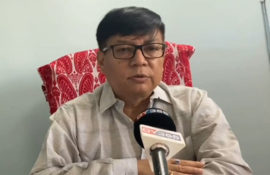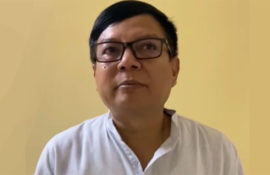Leader of the Opposition in the ALA Debabrata Saikia has urged Speaker Biswajit Daimary to…
Indian State Says It’ll Require Study of Sanskrit, Raising Eyebrows
A classroom in the village of Dadara in Assam State. Sanskrit will become mandatory for students in the upper grades of all public high schools in the state. Credit Anupam Nath/Associated Press
MUMBAI, India — The government of the northeastern Indian state of Assam announced this week that Sanskrit, the ancient Hindu language of the Brahmin priesthood, would now be mandatory for students in the upper grades of all public high schools.
Wider teaching of Sanskrit has been championed by activists from the Bharatiya Janata Party and Hindu nationalists, who view it as a way to strengthen Indians’ knowledge of and respect for precolonial civilizations.
But the announcement was met with incredulity from groups representing students, who pointed out that some schools do not teach indigenous languages widely spoken in the area. Even in Sanskrit’s golden age, some 1,500 years ago, it was primarily used as a language of scholarly discourse. In census surveys since 2001, only 14,000 to 50,000 Indians list Sanskrit as their first language.
“We strongly oppose this decision because in our community, nobody normally uses Sanskrit,” said Lurin Jyoti Gogoi, general secretary of the All Assam Students’ Union.
Kamrul Islam Chaudhary, a secretary with the National Students’ Union of India from Assam, said that few teachers in the state were capable of teaching Sanskrit, and that outside instructors would have to be hired.
“What about the local people?” Mr. Chaudhary asked.
The decision to make Sanskrit mandatory applies to public school students in eighth through 10th grade, but the requirement will eventually be extended to primary schools, said Himanta Biswa Sarma, Assam’s education minister. Once primary schools are included, it will be necessary to train 56,000 teachers to meet the need, Mr. Sarma added.
The study of Assamese, which is spoken mainly in Assam State, or one of the other regional languages like Bodo or Bengali, will be made compulsory in the state’s private schools through eighth grade. Most Indian states teach three languages to their students, including a regional language and, usually, Hindi and English.
Members of opposition parties questioned the Sanskrit decision, saying that students were already overloaded and needed instruction in topics that were more relevant to their lives in Assam.
“Our children don’t know much about our history, culture and geography,” said Debabrata Saikia, who leads the opposition Indian National Congress in the state assembly. “So we want to make history and geography separate subjects in the school, but the government is not doing anything about it.”
Until now, history and geography have been lumped together with environmental studies, but Mr. Sarma said he intended to introduce separate textbooks for those subjects. In addition to Sanskrit, computer science will also now be required in state schools.
Mr. Sarma said the state government’s decision had received wide support, and he dismissed any dissent as a result of miscommunication. “They are not opposing the decision per se, just questioning how it will be implemented,” he said.
“I think at the end of the day, everybody will be happy,” he added. “The government is still working it out, and when it happens, it will come out as a good package.”
But some, like Mr. Chaudhary of the National Students’ Union, challenged that view and questioned the state government’s intent. Mr. Chaudhary called the Sanskrit requirement “a ploy” to insert “ideologues into every school,” referring in particular to the Rashtriya Swayamsevak Sangh, a Hindu right-wing group closely affiliated with the Bharatiya Janata Party.
A version of this article appears in print on March 4, 2017, on Page A7 of the New York edition with the headline: Sanskrit, Spoken by Few but Loved by Hindu Nationalists,
By AYESHA VENKATARAMAN NY Times



